Craving pizza but need a gluten-free option that doesn’t taste like cardboard? This gluten free pizza dough delivers everything you love about classic crust—crispy edges, chewy middle, and a flavor that pairs perfectly with all your favorite toppings. Whether you’re gluten-intolerant or just trying something new, this recipe brings you a homemade crust that’s both easy and satisfying. No need for complicated ingredients—just a few pantry staples, and you’ll have a dough that rivals traditional pizza. Perfect for pizza night, this recipe is a game-changer for gluten-free cooking.
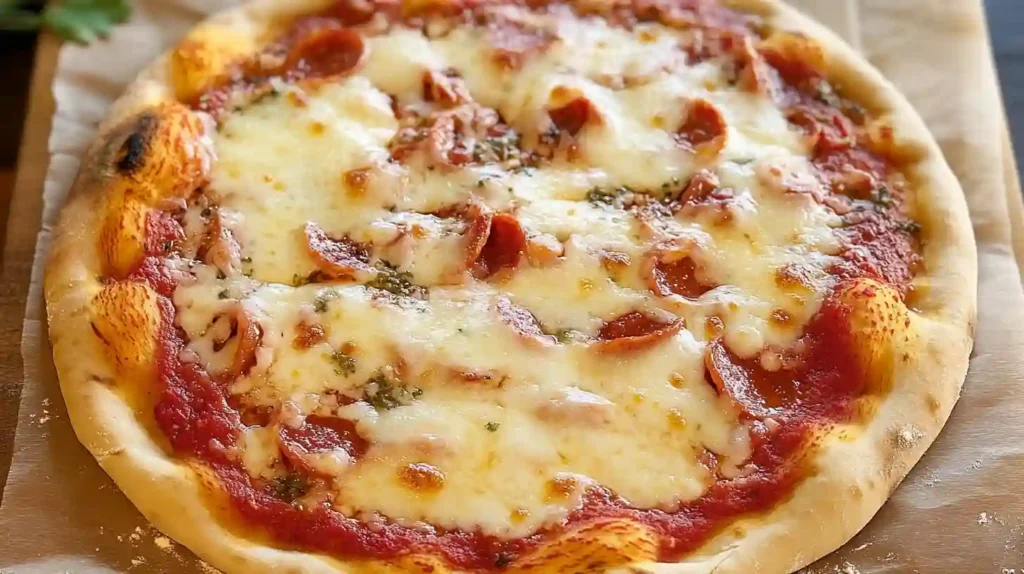
Table of Contents
Why You’ll Love This Recipe
• Crispy, Chewy Texture: This gluten free pizza dough bakes into a crust that’s both golden and crisp on the outside, yet soft and chewy inside—just like classic pizza crust.
• Simple Pantry Ingredients: No hard-to-find flours here. With basic gluten-free flour, yeast, olive oil, and a splash of vinegar, you’re ready to go.
• Versatile for Any Toppings: Whether you’re piling on veggies, meats, or cheese, this dough holds up beautifully without becoming soggy or crumbly.
• Perfect for Beginners: Even if you’ve never made pizza dough before, this step-by-step recipe is easy to follow and forgiving.
• Gluten-Free and Dairy-Free Option: Easily make it dairy-free by choosing your favorite plant-based cheese or skipping it altogether.
Ingredients
Here’s everything you’ll need to make this delicious gluten free pizza dough:
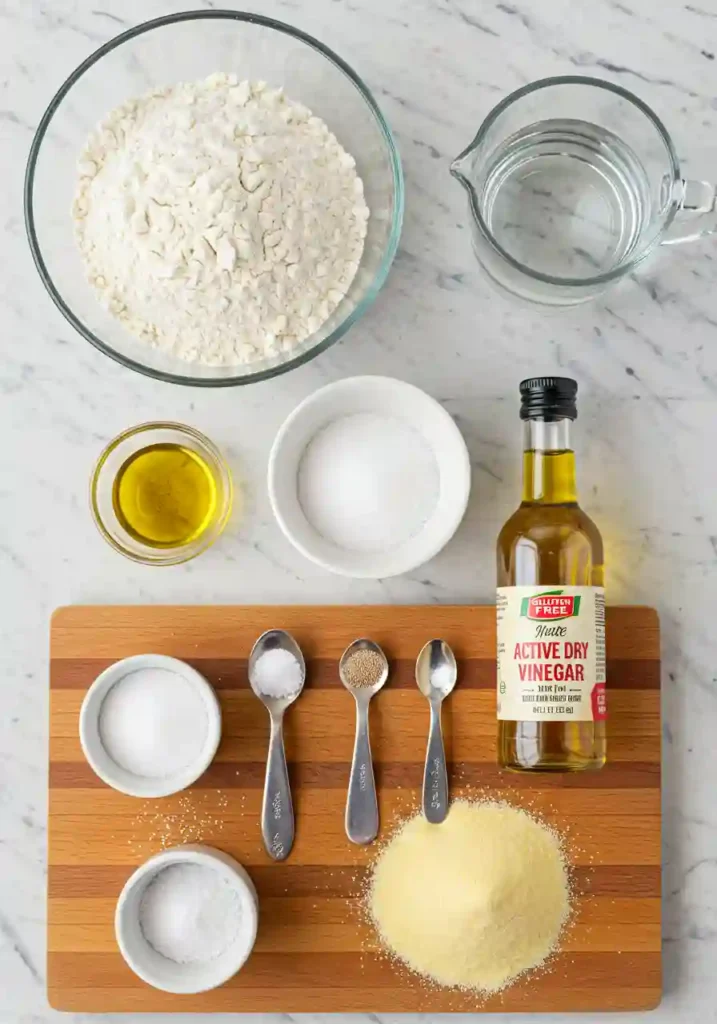
Dough Ingredients:
• 2 ½ cups gluten-free all-purpose flour blend (with xanthan gum)
• 1 tablespoon active dry yeast
• 1 teaspoon sugar
• ¾ cup warm water (about 110°F)
• 2 tablespoons olive oil
• 1 teaspoon apple cider vinegar
• ½ teaspoon salt
Optional for Texture & Flavor:
• 1 tablespoon cornmeal (for dusting baking surface)
• 1 teaspoon garlic powder or dried herbs (for added flavor)
Note: If your flour blend doesn’t contain xanthan gum, add 1 teaspoon separately.
These simple ingredients come together to form a soft, pliable gluten free dough that’s perfect for pizza night.
Instructions
Follow these simple steps to make the best gluten free pizza dough from scratch:
Step 1: Activate the Yeast
• In a small bowl, combine the warm water, sugar, and active dry yeast.
• Let it sit for 5–10 minutes, until foamy. This means the yeast is active.
Step 2: Mix the Dough
• In a large mixing bowl, whisk together the gluten-free flour, salt, and xanthan gum (if not included in the flour blend).
• Add in the olive oil, apple cider vinegar, and the yeast mixture.
• Mix using a wooden spoon or dough hook until a sticky dough forms. Add a tablespoon of water at a time if it feels too dry.
Step 3: Let the Dough Rise
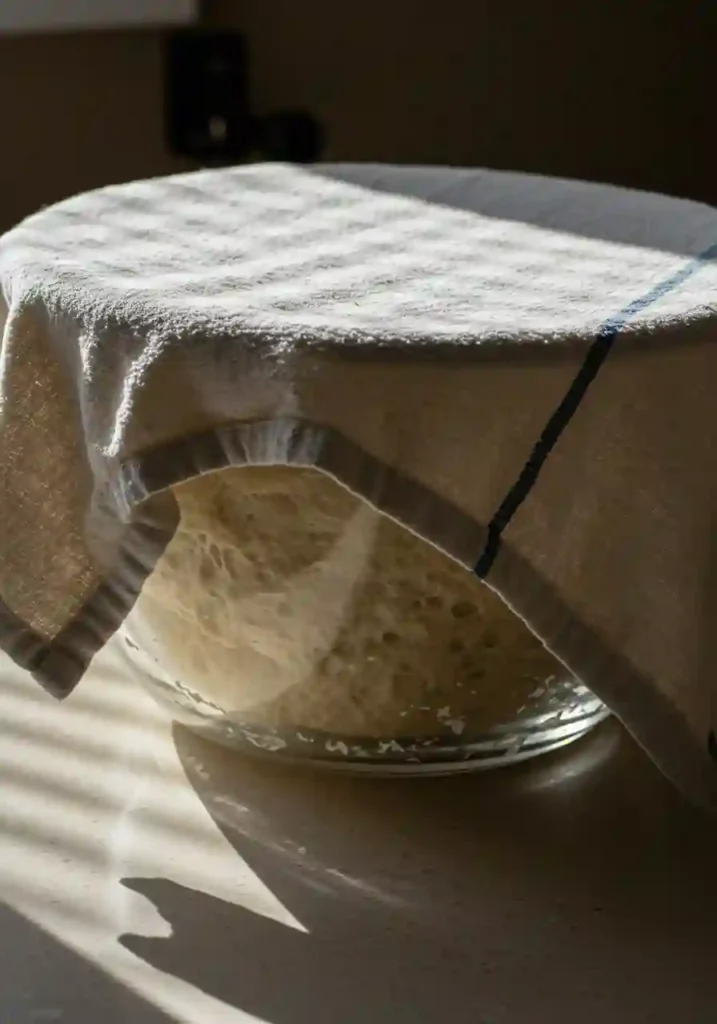
• Cover the bowl with plastic wrap or a clean towel.
• Let the dough rise in a warm spot for 30–45 minutes, or until slightly puffed.
Step 4: Preheat and Prepare
• Preheat your oven to 425°F (220°C).
• If using a pizza stone, place it in the oven while it preheats.
• Line a baking sheet or pizza pan with parchment paper and lightly dust with cornmeal or flour.
Step 5: Shape the Dough
• Transfer the dough onto the prepared surface.
• Use oiled hands or a spatula to spread the dough into a circle or rectangle, about ¼ inch thick.
Step 6: Parbake the Crust
• Bake the crust (without toppings) for 8–10 minutes.
• Remove from the oven and add your desired pizza sauce, cheese, and toppings.
Step 7: Final Bake
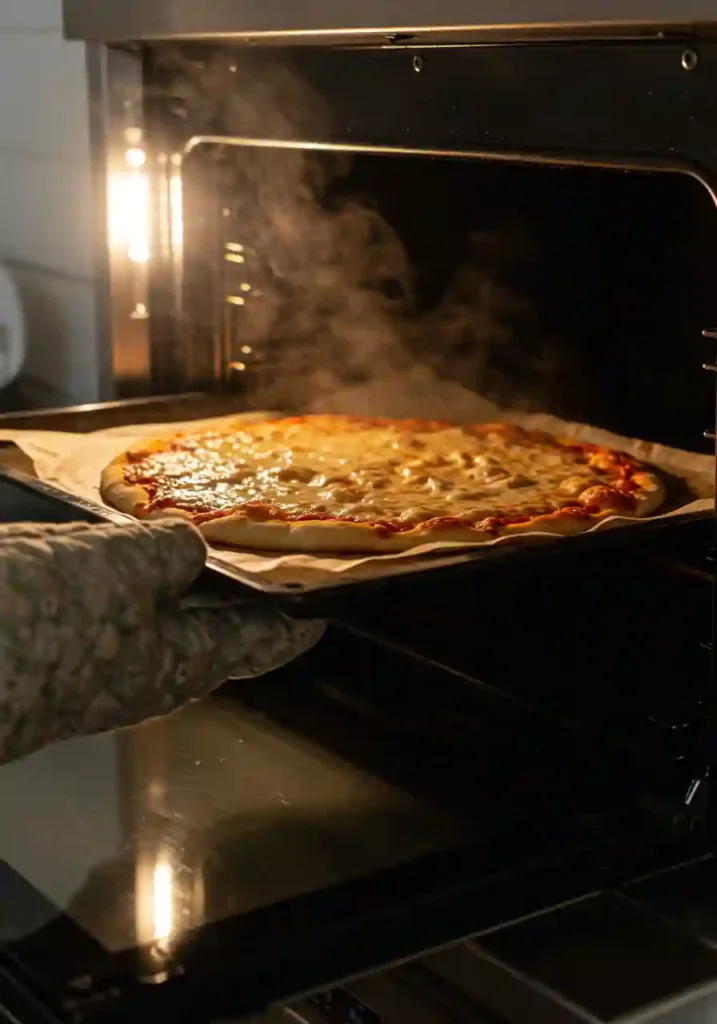
• Return to the oven and bake for another 10–15 minutes, or until the edges are golden and the cheese is bubbly.
Tip: For a crispier bottom, bake directly on the oven rack for the last 2 minutes.
Now you’re ready to enjoy a homemade, gluten free pizza with a crust that’s soft, chewy, and packed with flavor.
Pro Tips and Variations
Master your gluten free pizza dough with these practical tips and delicious ways to change it up:
Pro Tips
• Use a gluten free flour blend with xanthan gum: If your flour doesn’t include it, add 1 teaspoon per cup to improve elasticity and structure.
• Let the dough rest after mixing: This gives the flour time to absorb moisture and helps the dough become easier to shape.
• Oiled hands = easier handling: Gluten free dough is stickier than traditional dough, so lightly oil your hands when spreading it.
• Pre-bake the crust: Always parbake before adding toppings to prevent sogginess and ensure a sturdy base.
• Watch your oven temp: Use an oven thermometer if possible. Gluten free dough benefits from a hot oven—around 425°F ensures proper browning.
• Store leftover dough correctly: Wrap tightly and refrigerate for up to 2 days or freeze for up to 3 months. Let it come to room temp before shaping.
Variations
• Herb-Infused Crust: Mix in 1 tsp of dried oregano, basil, or rosemary into the dry ingredients for an extra burst of flavor.
• Cheesy Crust: Add ¼ cup grated Parmesan or shredded mozzarella to the dough for a cheesy, golden edge.
• Dairy-Free Option: Use dairy-free cheese and avoid any milk-based toppings to keep your pizza fully dairy-free.
• Vegan Version: Ensure your sugar is vegan-friendly and skip animal-based toppings like pepperoni or cheese.
• Thin Crust: Spread the dough thinner (about ⅛ inch) and bake a few extra minutes for a crispier texture.
This section helps you adjust and perfect your gluten free pizza dough no matter your preference or dietary needs.
Serving Suggestions
This gluten free pizza dough creates a delicious base for endless pizza creations. Whether you prefer classic toppings or adventurous flavors, here are some ways to serve your homemade pizza:
Classic Margherita
Top the baked crust with crushed tomatoes, fresh mozzarella, and basil leaves. Drizzle with olive oil before slicing for a simple, fresh option.
Veggie Supreme
Spread a tomato or pesto base, then add sautéed mushrooms, bell peppers, red onions, and black olives. Sprinkle with mozzarella and bake until golden.
Garlic White Pizza
Skip the red sauce and use a garlic butter base. Add ricotta, mozzarella, and spinach or kale. Top with cracked black pepper and chili flakes.
BBQ Chicken Pizza
Spread barbecue sauce on the crust, layer with shredded chicken, red onion, and a blend of cheddar and mozzarella. Bake and garnish with fresh cilantro.
Vegan Delight
Use a dairy-free cheese, tomato sauce, and a mix of roasted vegetables like zucchini, eggplant, and bell pepper. Add arugula after baking for a peppery finish.
Sweet Finish
Turn your crust into a dessert! Brush with a little coconut oil, sprinkle cinnamon and sugar, then bake. Top with fruit and a drizzle of honey or maple syrup.
Storage & Reheating
• Store leftover slices in an airtight container in the fridge for up to 3 days.
• Reheat in a skillet over low heat or in a toaster oven to maintain crispiness.
• Freeze individual crusts or baked pizzas (sliced) for up to 2 months.
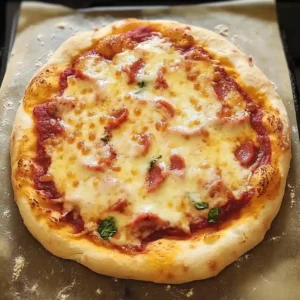
Gluten Free Pizza Dough
Ingredients
Dough Ingredients
- 2 cups gluten-free flour blend 1:1 baking blend with xanthan gum
- 1 tbsp instant yeast
- 1 tsp sugar
- 1 tsp salt
- 1 tsp apple cider vinegar
- 2 tbsp olive oil
- 3/4 cup warm water about 110°F
Instructions
- In a large mixing bowl, whisk together the gluten-free flour, yeast, sugar, and salt.
- Add the warm water, olive oil, and vinegar. Stir until the dough comes together.
- Cover the bowl with a towel and let the dough rest for 30 minutes.
- Preheat your oven to 425°F (220°C). Line a baking sheet with parchment paper.
- Transfer the dough onto the parchment paper. Lightly oil your hands and press the dough into a 10–12 inch round pizza shape.
- Bake the crust for 10 minutes. Remove, add toppings, and return to the oven for an additional 5–7 minutes or until golden and crisp.
Notes
- Calories: 240
- Carbohydrates: 45g
- Protein: 4g
- Fat: 5g
- Saturated Fat: 0.5g
- Cholesterol: 0mg
- Sodium: 300mg
- Potassium: 120mg
- Fiber: 3g
- Sugar: 1g
- Vitamin A: 0% DV
- Vitamin C: 0% DV
- Calcium: 20mg
- Iron: 1.5mg
Conclusion
This gluten free pizza dough is the answer to craving a satisfying, crispy, and flavorful pizza without sacrificing dietary needs. Made with simple pantry staples and easy-to-follow steps, it delivers a soft, chewy texture with a perfectly crisp edge—everything you want in a homemade crust.
Whether you’re gluten-sensitive, cooking for someone who is, or simply exploring new recipes, this dough offers flexibility and flavor in every bite. From classic cheese to bold veggie combos or even dessert pizzas, the possibilities are endless.
With a little prep and the right gluten free flour blend, you’ll never miss traditional pizza again. Try it for your next pizza night—it might just become your new go-to dough recipe.
FAQs
What gluten free flour is best for pizza dough?
The best gluten free flour for pizza dough is a 1:1 gluten free flour blend that includes xanthan gum. These blends mimic the texture of traditional flour and help the dough hold together.
Does yeast work with gluten free flour?
Yes, yeast works with gluten free flour. While the rise might be more subtle than with wheat flour, it still adds flavor and improves the dough’s texture.
Why use vinegar in gluten free baking?
Vinegar reacts with baking soda or baking powder to provide extra lift and tenderness in gluten free doughs. It also enhances flavor and improves the crumb structure.
Why is my gluten-free pizza dough not rising?
Common reasons include expired yeast, dough that’s too cold, or insufficient resting time. Gluten free dough also rises less dramatically, so be patient and ensure a warm environment.
What flour is gluten-free?
Gluten-free flours include rice flour, almond flour, coconut flour, oat flour (certified GF), and sorghum flour. Blends that combine these with starches and gums offer the best results.
Does gluten-free pizza take longer to cook?
Gluten-free pizza doesn’t necessarily take longer to cook, but the crust may need a few extra minutes to achieve a crispy bottom. Pre-baking the crust before adding toppings helps.


